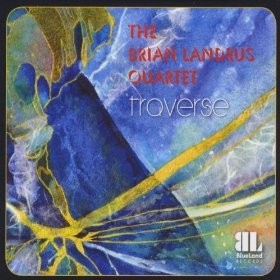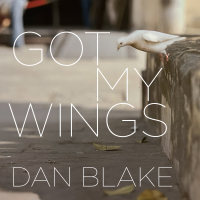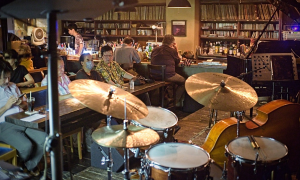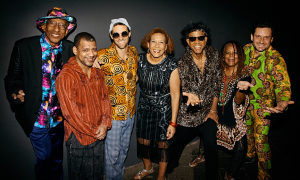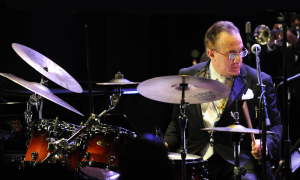Home » Jazz Articles » In the Artist's Own Words » Steve Khan: The Making of "Parting Shot"
Steve Khan: The Making of "Parting Shot"
During the preparation phase of this recording, I was asked if I had any tunes laying around that might be suitable for guitarist Bernie Williams, and so, I sent him the original demo for "Zancudoville." When I listened to it again, I said to myself: "Steve, you know, this tune is really too good to not record it yourself—and this is going to be your best chance to do it right." So, armed with the new [A] melody, I decided that the best way to record the tune, and to be able to play it live with the right feeling and atmosphere, would be to prerecord my acoustic guitar, which is also essential to the feel and attitude, alongside Rob's beautiful Rhodes sound. We did that, leaving lots of room for soloing live. The final touch was to play the güiro part myself—always a thrilling moment for me.
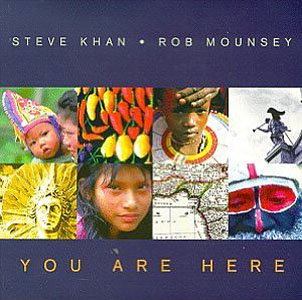 During the rehearsals, I spoke with Manolo about the kind of atmosphere that I hoped that he could create for the piece. And, as you can hear, he did just that—lots of swampy, jungle, mosquito-infested sounds. I also asked him to use his fantastic speaking voice to "whisper to" the zancudos, and to tell them to "stop bothering me"—that "I see you, I see you—that they are "very annoying," and last, but not least, "catch me if you can!"
During the rehearsals, I spoke with Manolo about the kind of atmosphere that I hoped that he could create for the piece. And, as you can hear, he did just that—lots of swampy, jungle, mosquito-infested sounds. I also asked him to use his fantastic speaking voice to "whisper to" the zancudos, and to tell them to "stop bothering me"—that "I see you, I see you—that they are "very annoying," and last, but not least, "catch me if you can!" While assembling the music for this recording, of course, I knew that somewhere on some of the songs, Manolo Badrena would sing the various vocalese sections. But, my other dream or fantasy for the recording was to see if I could somehow get Gracinha Leporace, Sergio Mendes' wife and the main voice of all of his recordings, to sing on some of the pieces. She is capable of so much more than just the usual breathy singing style associated with most Brazilian female singers. And so, I tried with all my powers of persuasion and begging through my good friend Mike Shapiro, who plays drums with Sergio, to see if Gracinha would be willing to sing on something. In the end, all my efforts failed. Monstrous bummer!!!
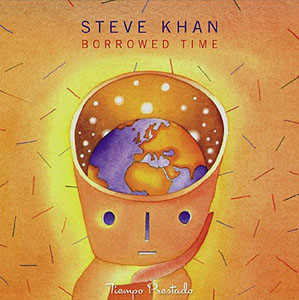 As the process of making demos for all the songs began, and I had enlisted the help of Rob Mounsey to do them for me—I knew that I had to have some scratch vocals so that Manolo could study and learn these vocal sections. One day, I went over to James Farber's apartment to play him some of the demos. He wanted to hear the scope of the music so that he could conceptualize the studio setup and all the mics that he would need to request from Avatar Studios. As I played "Zancudoville" for him, I just sang along with the [B] section when it arrived. I thought nothing of it. But, after hearing me sing it, James asked in a most complimentary fashion, "Are you going to sing that yourself?" I responded by saying, "Of course, not! Manolo will eventually do it."
As the process of making demos for all the songs began, and I had enlisted the help of Rob Mounsey to do them for me—I knew that I had to have some scratch vocals so that Manolo could study and learn these vocal sections. One day, I went over to James Farber's apartment to play him some of the demos. He wanted to hear the scope of the music so that he could conceptualize the studio setup and all the mics that he would need to request from Avatar Studios. As I played "Zancudoville" for him, I just sang along with the [B] section when it arrived. I thought nothing of it. But, after hearing me sing it, James asked in a most complimentary fashion, "Are you going to sing that yourself?" I responded by saying, "Of course, not! Manolo will eventually do it." Sometime later, I decided to just add my voice to the demo, so that I could help Manolo. At that time, I was bartering guitar lessons for Pro-Tools lessons, and I asked my student, my teacher, if he could bring a microphone so that we could record my voice for those sections. He was very gracious about it, and brought a mic. I sat next to my computer, and sang the parts. Later in this process, when Rob Mounsey heard my "scratch vocal" track on the demo, he commented, "This sounds perfectly great to me, you sound like Kenny Rankin!" Well, how bad could that be? I couldn't believe it!
But, I was still convinced that Manolo should do the vocal. And so, on December 15, when Manolo arrived at Rob's studio to sing his vocals for both "María Mulambo" and "Just Deserts"—I had planned that he would sing "Zancudoville" too. But, the final endorsement came from Manolo himself, when he told Rob and me that he felt that my vocal was really great, and that it would be crazy for him to try to replace it. So, I just decided to re-sing it myself, and that is what you now hear.
The electric guitar sound that you hear on this tune is one that I haven't really used on a recording of mine in ages, probably not since the tune Casa Loco. That was 27 years ago. Each time that I recreate this sound, I often wonder to myself just why I don't use it more often. I have no good answer for that.
[10] Just Deserts (Su merecido) (Steve Khan)(6:14)
Before I write another word, the title always should have been "Just Deserts"—with only one 's'—but, for the longest time, I had it written as "Just Desserts"! This just shows how literate I really am. Perhaps some of my more well-educated colleagues thought that I was making some kind of a joke? Fortunately, I corrected it before the CDs were printed.
On my last two studio recordings, I have wanted to have pieces that served as "percussion jams" in order to feature the great Latin percussionists, and the drummer. On The Green Field (2005), I composed "Cosecha lo que has sembrado" with that in mind. And, on Borrowed Time (2007), McCoy Tyner's "Hymn Song" was used to the same end. Here, I wanted to feature three of my favorite percussionists, Bobby Allende(conga); Marc Quiñones(timbal); and, of course, the great, great Dennis Chambers(drums).
The [I] section theme is also something that I had been playing at home on guitar for the longest time, without any sense of what it could be, or could become. It just seemed to exist by itself without a specific direction. But, when the idea of turning it into a percussion piece came to me, and I saw an avenue to pursue, I just worked within a familiar song form, one that mirrors something closely associated with the harmonic movement of tunes like "So What" or "Impressions."
This kind of solo format gives each percussionist something to play against rather than just playing into open space. To glue the tune together, I used another common device as an interlude, and that was to have the vocal section of the intro, which features Manolo Badrena, reappear in-between each percussion solo. Finally, after Dennis' drum solo, at the very end of the piece, the main guitar melody enters, embellished by my Zawinul-esque Korg DVP-1 harmonized lines.
As I have stated before, this outboard device is like having my own "psychedelic big band" right in my hands. Zawinul's old keyboard tech, Ralph Skelton, helped me out greatly by rigging-up an on/off switch that enables me to use the DVP-1 whenever the moment seems right. I can store up to five banks of sonorities, each with eight programmed options. This gives me a wide harmonic palette from which to choose. To have these options, and to be able to employ them spontaneously, has been a great luxury for me.
The solos appear in the order that I have used on the prior two studio recordings: Bobby Allende(conga); Marc Quiñones(timbal); and finally, Dennis Chambers(drums). To repeat: in between each of the solos, the vocal refrain, sung by Manolo Badrena appears. After I have stated the main guitar melody, I finally do some improvising over the basic [A][A][B][A] song form. For me, it's a great way to end the journey that has been the making of Parting Shot."
Thanks so much to you for now having become part of it!
Photo Credit
All Photos: Richard Laird
Tags
PREVIOUS / NEXT
Support All About Jazz
 All About Jazz has been a pillar of jazz since 1995, championing it as an art form and, more importantly, supporting the musicians who make it. Our enduring commitment has made "AAJ" one of the most culturally important websites of its kind, read by hundreds of thousands of fans, musicians and industry figures every month.
All About Jazz has been a pillar of jazz since 1995, championing it as an art form and, more importantly, supporting the musicians who make it. Our enduring commitment has made "AAJ" one of the most culturally important websites of its kind, read by hundreds of thousands of fans, musicians and industry figures every month.



